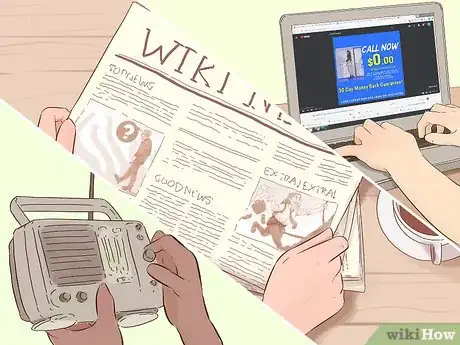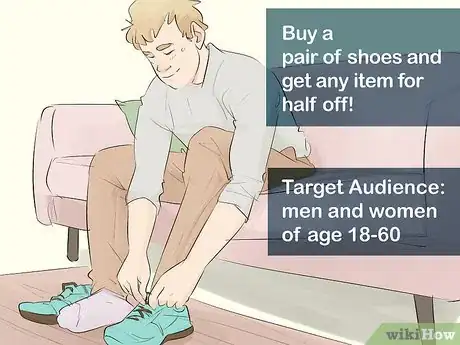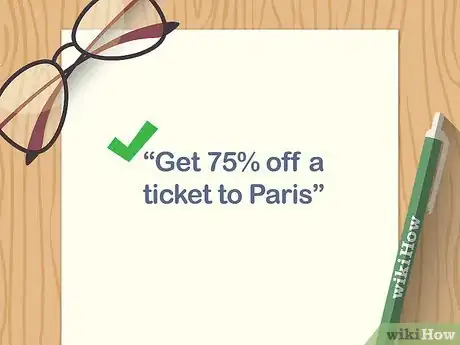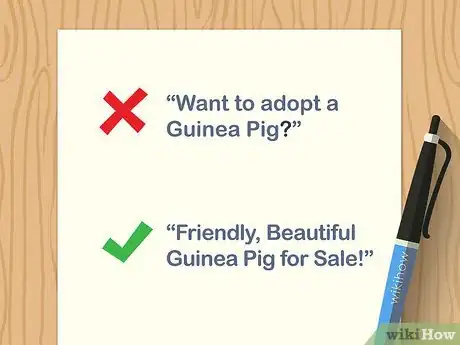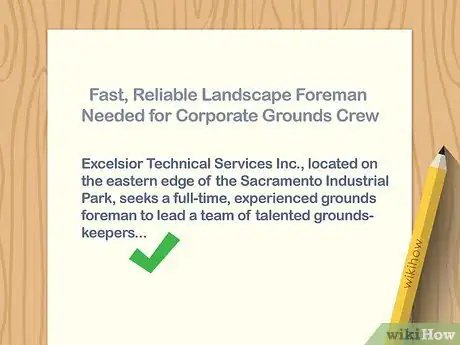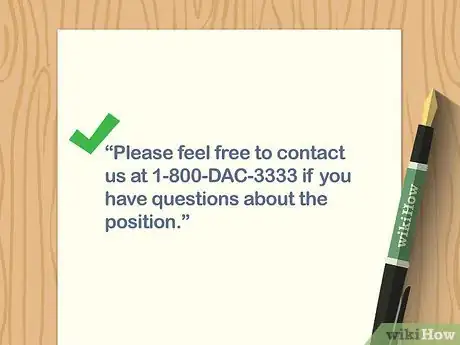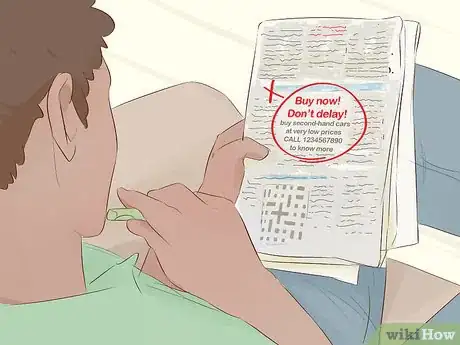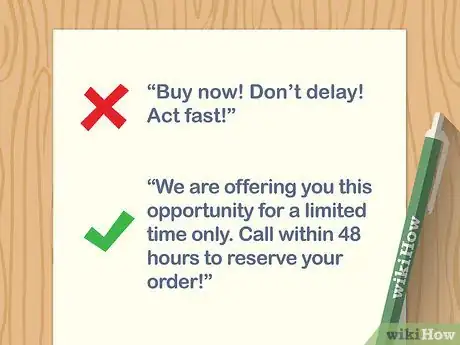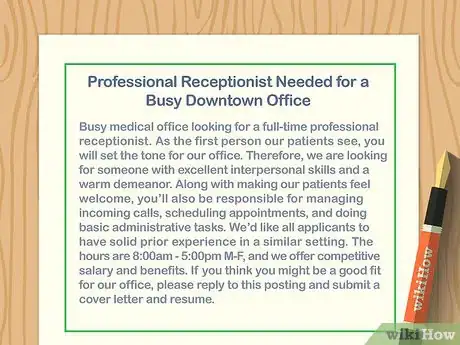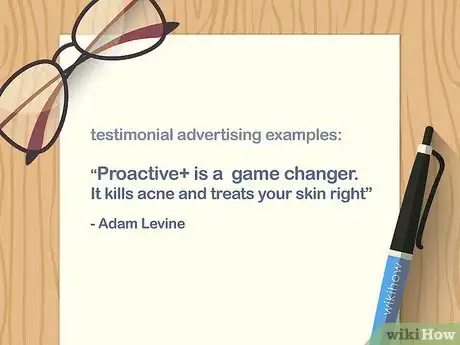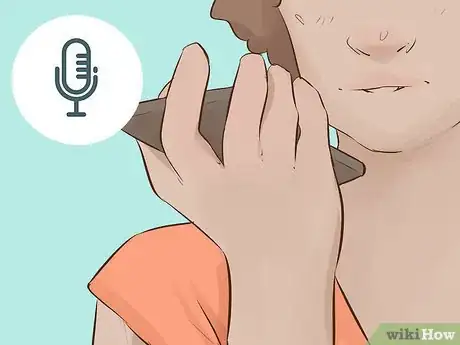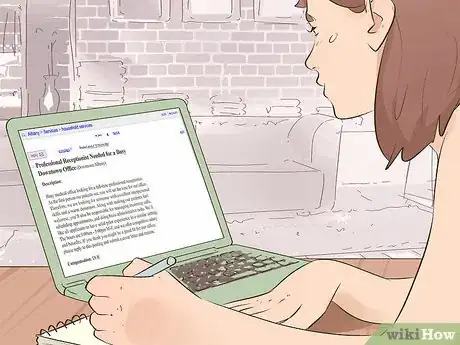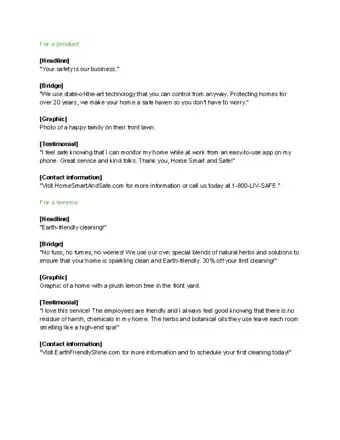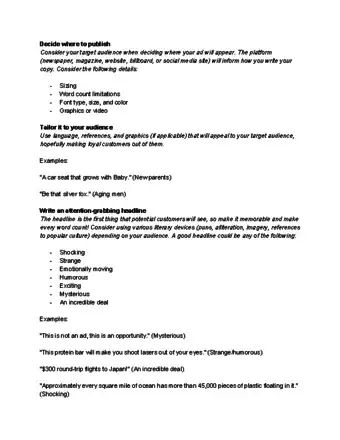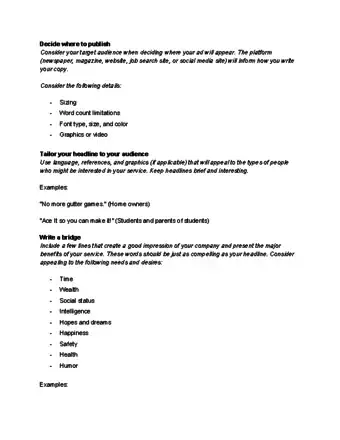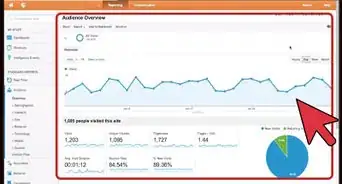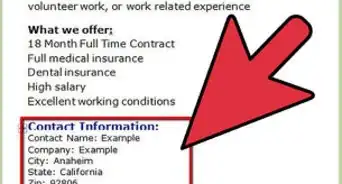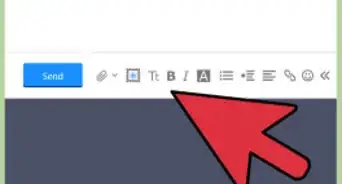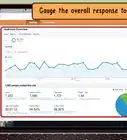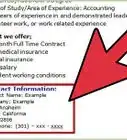This article was co-authored by Emily Hickey, MS. Emily Hickey is the Founder of Chief Detective, a social media growth agency that helps some of the world’s top retailers and start-ups scale their Facebook and Instagram advertising. She has worked as a growth expert for over 20 years and received her Master’s from the Stanford Graduate School of Business in 2006.
There are 7 references cited in this article, which can be found at the bottom of the page.
This article has been viewed 488,253 times.
If you're in business you know that to attract customers and get results, you have to advertise. A great ad attracts attention, generates interest in your product, and leaves consumers with a strong desire to buy it. See Step 1 and beyond to learn the tenets of writing a compelling and effective ad.
Steps
Mastering the Basics
-
1Decide where to publish the ad. Will your advertisement be printed in the newspaper, a magazine, your website, or Facebook? Knowing where you plan to publish the ad will influence the way you write your copy. Find out the perimeters of your advertising space, including how many words you're allotted, how large the font size will be, and whether you can incorporate graphics or video. Ultimately, the traditional classifieds-style ad will fly in almost any medium, but you might need to make small tweaks to tailor it to the space in which you're advertising.[1]
- If you're taking out a quarter to full-page advertisement in your local newspaper, you're going to have some room to play around with a paragraph or so of copy.
- However, for a Facebook or other online ad, your copy will be limited to a sentence or so.
- Either way, when you're writing an ad, every word counts. Being too vague or wordy will cause people to skim your advertisement instead of pausing to read it, so the same writing tenets apply no matter what type of ad you're writing.
-
2Tailor it to your audience. Which consumers are you targeting? Ideally, everyone who reads your ad will want to buy your product, but in reality you'll have better results if you tailor your ad to a specific audience that is likely to be more interested than the rest of the world. Use language and references that appeal to the demographic to which your product appeals. It might be a turnoff for other groups of people, but it's important to speak to the hearts of the people who have the potential to become loyal customers.[2]
- For example, if you're selling a service that allows people to self publish their books, you'll want to use language that sounds writerly and elegant. That way your target audience - people who have written books they want to publish - will know they would be in good hands with your company.
- If you're selling a product that appeals to a younger crowd, like a new type of candy that makes your mouth turn rainbow colors, lose the formality and use language that's familiar to your target audience - kids who want to spend their allowance on candy, or who could influence their parents to buy the candy for them.
Advertisement -
3Write an attention-grabbing headline. This is the most important part of your advertisement, because it's your one shot at getting consumers to actually read your ad. If your headline is vague, difficult to understand or in any way uninteresting, you can't expect people to take the time to read the rest of your carefully-written ad. You're immediately telling them that your company isn't innovative enough to come up with a compelling ad - which will reflect poorly on your product as well, even if it's excellent.[3]
- People riding the subway, scrolling through Facebook or flipping through a magazine have hundreds of little pulls on their attention. How can you cut through all the noise and make them focus on your product? Think of a headline so compelling that it essentially forces the person reading it to pay attention.
- Your headline could be something shocking, strange, emotionally compelling, or exciting - it doesn't matter, as long as it grabs the reader. For example,
- Write something mysterious: Don't be happy, be terrified.
- Write something people can't pass up: Get 75% off a ticket to Paris.
- Write something emotional: She has 2 weeks to live.
-
4Don't start with a question. You might be able to get away with a highly creative and compelling rhetorical question, but stay away from your standard "Do you need a new car?" type of opener. Consumers have already read thousands of similar questions, and they're tired of being asked. You'll have to dig a little deeper to capture their attention. Find a creative way to tell people that you have what they need without asking an obvious question.
-
5Write a bridge to keep them reading. The next line after your headline is your short, sweet chance to create a solid impression of your company in the minds of your audience. After your mysterious/shocking/emotional headline, you need to follow up with something substantive - otherwise, your headline will be perceived as mere hype.[4] Use the bridge to tell the consumer what need your product can fill.
- Remember that every word counts. Your bridge language needs to be just as compelling as your headline, because there's still a good chance you could lose people before they get to the end of your ad.
- Touch on the major benefits your product will bring the consumer.[5] Your bridge should contain your strongest selling points.
-
6Create desire for your product. Your bridge also serves as a chance to create a strong desire for your product. It's a chance to play with your audience's emotions and make them feel as though your product will fill a need they have. If this sounds manipulative, it is - but if you're offering a product that will actually be helpful to people, there's no shame in writing copy that tugs on the heartstrings to get people to buy a product that will improve their lives.
- Nostalgia can be an effective tool to capture people's hearts. For example, We use the finest heirloom peppers to make hot sauce as good as Grandpa's secret recipe.
- Playing to people's health concerns can also work well: You're doing the hard work - quitting. Let us help you get your life back.
- Don't forget to include the name of your company and your product somewhere in your copy.
-
7Tell them how to get your product. Finally, write a strong ending that tells your audience exactly what to do next. Give them an action to take that makes it easy for them to buy your product or get in touch.
- It's common for ads to include a straightforward directive, like Call 555-5555 for more information.
- You could also just list your website, and people will know to go there to buy your product.
Refining Your Ad
-
1Dissect bad ads. When you're new to writing ads, it can help to break down other ads and figure out where they went wrong. Find a few bad ads - you'll know they're bad because your first impulse will be to skim right over them - and try to figure out what makes them so ineffective. Is it the headline? The bridge? The tone?
- Once you've pinpointed what makes the ad bad, think about how you could make it better. Rewrite the ad to make it more effective.
- Take a look at effective ads, too, and try to determine what makes them great.
-
2Make it sound natural. When you write your own ad, try to make it sound as natural as you can. Write it as though you're saying it to someone else. People are drawn to natural writing - it speaks to them in a way that overly formal, stilted writing just doesn't.[6]
- Don't be too stiff - you want your audience to feel accepted and understood.
- Don't be too friendly, either - you could come off sounding fake.
-
3Keep it brief. No matter where your ad is published, you should keep it short and sweet. People don't have time to read an ad that requires more than about 30 seconds of their attention - or less. They're encountering your ad on their way to doing something else, like reading an article or getting off the train or bus they're riding. Your ad should be interesting enough to make a big impression using very few words.[7]
- Since your ad will be short, make it very specific. Don't use vague language and get to the point right away.
- Use short sentences instead of long ones. Longer sentences are difficult to take in in a short period of time.
- Play with your copy so that you say what you want to say in as few words as possible. It's not necessary to use complete sentences, as long as your message gets across clearly.
-
4Consider using testimonials. These days, people want to read reviews and testimonials before buying a product. They aren't usually content to try it out until they're reasonably sure that it has worked for other people. Incorporating a testimonial or two into your ad could be a great way to build trust with your audience right off the bat.
- Choose a quote from a well-respected customer, if possible. For example, if you're selling a health product, use a quote from a doctor or another health professional.
- If you're short on space, you can always put testimonials on your website instead of using them in your ad.
-
5Use graphics wisely. If you have the opportunity to use an image or video in your advertisement, think carefully about your ad's composition. Having an image will allow you to use fewer words - you won't necessarily need to describe your product's features or state what it does. Instead, Juxtapose the picture or video with an intriguing headline or tagline and your company's URL.
- The image or video you choose is just as important as the copy you write - if not more important. Choose graphics that compel your readers on an emotional level and make them desire your product.
-
6Record yourself saying it aloud. Once you have your ad written, record yourself reading it or saying it to someone. Play it back to yourself. Does it sound conversational? Is it compelling? If someone said it to you, would your interest be piqued? Reading it out loud is a good way to spot deficiencies that could cause your ad to fall flat.
-
7Test your ad. Go ahead and publish it in a few places to see what kind of reception it gets. Hopefully, you'll see your sales start to increase. You can determine whether new business is a direct result of your ad by asking customers how they heard about your company. If they reference your ad, you know it's working![8]
-
8Rewrite it until it works. Don't keep publishing an ad that isn't increasing your sales. Keep rewriting it until you're confident it's actually bringing in more business. A poorly-written ad that doesn't represent your company well can actually do more harm than good. After you've used your ad for a few months, keep things fresh by rewriting it to advertise a new product or feature.
Annotated Advertisements
Expert Q&A
-
QuestionWhich online advertising is best?
 Emily Hickey, MSEmily Hickey is the Founder of Chief Detective, a social media growth agency that helps some of the world’s top retailers and start-ups scale their Facebook and Instagram advertising. She has worked as a growth expert for over 20 years and received her Master’s from the Stanford Graduate School of Business in 2006.
Emily Hickey, MSEmily Hickey is the Founder of Chief Detective, a social media growth agency that helps some of the world’s top retailers and start-ups scale their Facebook and Instagram advertising. She has worked as a growth expert for over 20 years and received her Master’s from the Stanford Graduate School of Business in 2006.
Marketing Consultant & Master's Degree, Business, Stanford University Marketing Consultant & Master's Degree, Business, Stanford UniversityExpert AnswerSocial media is really becoming video-first, particularly on Facebook and Instagram, and creating a video doesn't have to be complicated. You can even just take your product imagery and cobble it into a video montage with text overlays.
Marketing Consultant & Master's Degree, Business, Stanford UniversityExpert AnswerSocial media is really becoming video-first, particularly on Facebook and Instagram, and creating a video doesn't have to be complicated. You can even just take your product imagery and cobble it into a video montage with text overlays. -
QuestionCan you give tips on the techniques for using persuasive language in ads?
 Community AnswerTry to use imperatives. These are verbs which tell someone to do something. Be mindful of how it sounds. If it helps, read the sentence out. This is because you do not want to appear to forceful as if you do it can put people off and make you seem overly aggressive or pushy.
Community AnswerTry to use imperatives. These are verbs which tell someone to do something. Be mindful of how it sounds. If it helps, read the sentence out. This is because you do not want to appear to forceful as if you do it can put people off and make you seem overly aggressive or pushy. -
QuestionHow should I write an advertisement for Nandini milk?
 Community AnswerYou can write anything as long as it's associated with the product. Some ideas are: Where does it come from? What is so great about it? You want to write something appealing or interesting about the product so more people will buy it.
Community AnswerYou can write anything as long as it's associated with the product. Some ideas are: Where does it come from? What is so great about it? You want to write something appealing or interesting about the product so more people will buy it.
References
- ↑ https://www.forbes.com/sites/forbesbusinessdevelopmentcouncil/2018/02/14/how-to-determine-the-best-ad-channel-to-use-in-2018/
- ↑ https://smallbusiness.chron.com/determine-demographic-group-advertising-22968.html
- ↑ https://mwdg.delaware.gov/files/2015/03/Power-of-a-Good-Headline-mwdg-.pdf
- ↑ http://www.entrepreneur.com/article/77682
- ↑ http://buzz.greatfxprinting.com/how-to-write-an-effective-advertisement.htm
- ↑ https://www.oxford-royale.co.uk/articles/make-writing-interesting.html
- ↑ https://www.mediapost.com/publications/article/321195/study-finds-consumers-prefer-longer-not-short-for.html
- ↑ http://www.entrepreneur.com/article/77682
About This Article
To write an advertisement, start with a headline that will grab your audience’s attention, like something funny, strange, or emotionally compelling. In the next line after your headline, concisely tell the reader what you’re offering and what the benefits are. Also, use this bridge sentence to create desire for your product, like by invoking nostalgia or playing to people’s health concerns, for example. Finally, include a strong ending that tells people how to get your product or how they can contact you for more information. For tips on how to use testimonials in your ad, keep reading!
